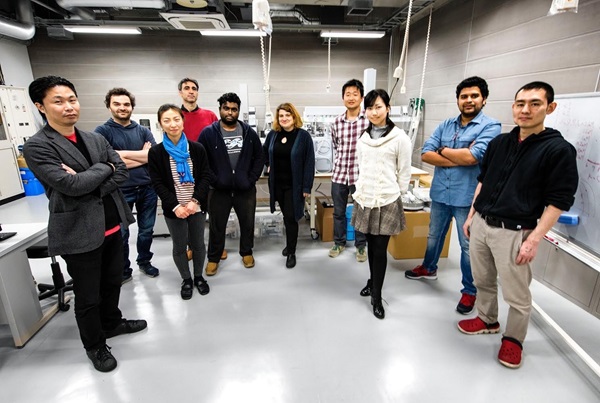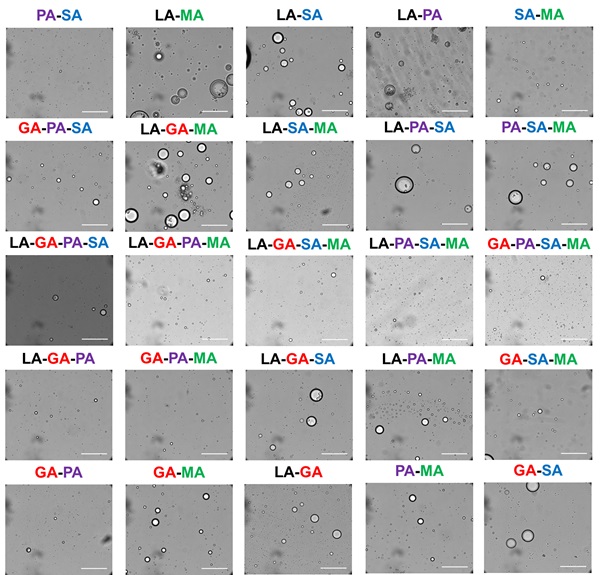Researchers often assume that primitive life contained the same components as modern biology. However, early Earth likely hosted mixtures of biomolecules and non-biomolecules, and it is clear that some aspects of biochemistry are the result of natural selection only after life originated. ELSI researchers have proposed new methods to study non-biomolecular model systems potentially relevant to the origins of life.

It remains unknown how life began. While it is reasonable to base models on modern biochemistry, such experiments may overlook geochemical realities on Earth billions of years ago, which contained a multitude of biomolecules and non-biomolecules that co-existed and co-interacted with each other. ELSI researchers—including Irena Mamajanov, Jim Cleaves, and Tony Z. Jia—and collaborators have proposed a methodology suggesting that studying other molecule types may offer new insights into studies of the origins of life.
One potentially common molecule type that may have been abundant on early Earth before life arose are molecules called alpha hydroxy acids (abbreviated as αHAs here). αHAs are very similar in structure to amino acids, modern biomolecules that are the building blocks of proteins. αHAs were likely present on early Earth, as they can be produced from a variety of chemical reactions of common gases that were present in the early atmosphere or delivered by meteorites. When solutions of αHAs are dried by simple heating which drives off water, the monomers spontaneously form polymers called polyesters. Although it is possible to form polymers of amino acids (peptides) under early Earth conditions, the formation of polyesters requires much less energy, and thus it has been proposed that polyesters were the first polymer systems on early Earth. Co-author Irena Mamajanov was one of the first researchers in the origins of life field to focus on polyesters in the context of origins of life. She has spent a large portion of her career studying primitive polyester systems, and has contributed the discovery of important properties of primitive polyesters (Mamajanov, Life 2019), including studies which illustrate how polyesters could have directly led to the emergence of peptides (Forsythe, et al., Angew 2019). Thus, although polyesters are generally thought of in the context of textiles, they may in fact be very relevant for the origins of life.
Starting from a pool of mixed αHAs simulating the complex chemical conditions on early Earth, repeated drying by heating and addition of water (which simulates the day-night evaporative cycle coupled with precipitation that could have occurred on early Earth) produces a diverse collection of polyesters. This process is one way complex mixtures of polymers could have formed during chemical evolution. This work was the first demonstration of its kind, and was pioneered by collaborator and co-author Kuhan Chandru of the National University of Malaysia (Chandru, et al. Comms. Chem. 2018). Next, the authors discuss that, during the polyester synthesis process, polyester gels may emerge after long periods of drying. These gels can assemble into droplets, which show life-like functions including segregation and compartmentalisation of nutrients, division and fission, and the ability to scaffold lipid assembly (Jia, et al. PNAS 2019). These droplets could have helped various chemical reactions and assembly processes on early Earth.
The authors finally suggest that the field of origins of life research should consider less ‘clean’ systems and focus more on complex systems which incorporate all of the types of molecules that likely were present on early Earth, regardless of whether they are used by modern biochemistry. However, such analyses will require methodological and technological development to be able to explore such complex chemical mixtures.
Co-author Cleaves, one of the first major proponents of a so-called ‘polyester world’, believes that studying such systems is essential for origins of life research. ‘Although life eventually settled on the biomolecules it currently uses, there is no reason to expect and no direct evidence that shows that the same molecules were the first molecules present during the origins of life. Perhaps other molecule types not used in modern biology played roles in the emergence of modern biomolecules.’


| Journal | Life |
| Tile of the paper | Polyesters as a Model System for Building Primitive Biologies from Non-Biological Prebiotic Chemistry |
| Authors | Kuhan Chandru1,2, Irena Mamajanov3, H. James Cleaves II3,4,5,6 and Tony Z. Jia3,4 |
| Affiliations | 1 Space Science Center (ANGKASA), Institute of Climate Change, Level 3, Research Complex, National University of Malaysia 2 Department of Physical Chemistry, University of Chemistry and Technology, Prague 3 Earth-Life Science Institute, Tokyo Institute of Technology 4 Blue Marble Space Institute for Science 5 Institute for Advanced Study 6 Center for Chemical Evolution, Georgia Institute of Technology |
| DOI | 10.3390/life10010006 |
| Online published date | January 19, 2020 |
